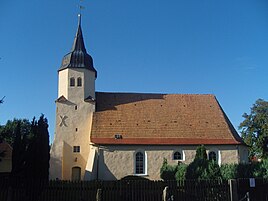Geierswalde
|
Geierswalde
Lejno Community Elsterheide
Coordinates: 51 ° 29 ′ 40 ″ N , 14 ° 7 ′ 30 ″ E
|
|
|---|---|
| Height : | 107 m above sea level NN |
| Area : | 20.47 km² |
| Residents : | 304 (December 31, 2016) |
| Population density : | 15 inhabitants / km² |
| Incorporation : | July 1, 1995 |
| Postal code : | 02979 |
| Area code : | 035722 |
|
Church in Geierswalde
|
|
Geierswalde , Upper Sorbian , is a district of the Saxon community Elsterheide in the district of Bautzen . It is part of the official Sorbian settlement area in Upper Lusatia .
The place has the character of a street village and is characterized in the center by narrowly lined up angular, three-sided and four-sided courtyards in mostly single-storey clinker construction as well as the village meadows along the main streets. At the farmsteads you can still find overbuilt gatehouses and gate entrances, wooden block barns and upper arbors. The church with its slightly inclined tower is in the focus from all through town. The waterworks east of the village is considered an industrial monument.
population
Germans and Sorbs live in the village . All streets in the village are signposted in both languages, the Koschen dialects are spoken here . Geierswalde is the birthplace of the last active Sorbian pastor of Senftenberg , Friedrich GP Schulze, he also found his resting place here in the local cemetery. Two Soviet soldiers who were executed as looters by the Soviet Army are also buried in the cemetery.
geography
Geierswalde is still in Lower Lusatia , about 12 kilometers northwest of the city of Hoyerswerda and about 12 kilometers southeast of the city of Senftenberg , the Black Elster flows in the south and the remaining hole of the former Koschen open-cast lignite mine, today's Geierswalder See, extends to the west .
The Brandenburg village of Kleinkoschen (Sorbian: Košynka ) is located on the western shore of Lake Geierswalde , about five kilometers away, and the village of Tätzschwitz (Sorbian: Ptačecy ) is about one kilometer away on the road to the south . After about two kilometers in a south-easterly direction you will reach the municipality of Laubusch ( Lubuš ) and after five kilometers in the north-east you will reach the village of Klein Partwitz ( Bjezdowy ). The Koschenberg ( Košynska hora ) is about eight kilometers southwest of the village.
history
There have been several attempts to interpret the place name, in Sorbian Lejno : there used to be a lot of herons , also known as vultures, in the swampy area of the magpie lowlands . Geierswalde is supposed to be called "Forest of Herons". The Sorbian name has been traced back to Len , which is flax or flax : "Village of flax cultivation". However, it seems correct to explain the name as “the clearing settlement of a man vulture ” and Lejno as a fiefdom (of the vulture).
Geierswalde belonged to the Hoyerswerda district . In 1961, the town of Scado, north of Geierswalde, was incorporated. In 1964 the new district was demolished by the Koschen open-cast mine. On July 1, 1995, the once independent municipality of Geierswalde became part of the municipality of Elsterheide.
The oldest building in the village is the Protestant church in the center of the village, it was built in 1678 as a hall church. The previous building burned down with the whole village in 1674. The tower was added in 1792; today it is inclined to the west due to the consequences of open-cast lignite mining. The inside of the church has been completely painted by W. Rittsche.
Population and language
For his statistics on the Sorbian population in Upper Lusatia, Arnošt Muka determined a population of 395 in the 1880s, including 388 Sorbs (98%) and only seven Germans. In 1956 Ernst Tschernik counted a Sorbian-speaking share of only 49.3% of the population in the village. Since then, the use of Sorbian has continued to decline in the village.
Web links
- Geierswalde on the website of the Elsterheide community
- Geierswalde in the Digital Historical Directory of Saxony




